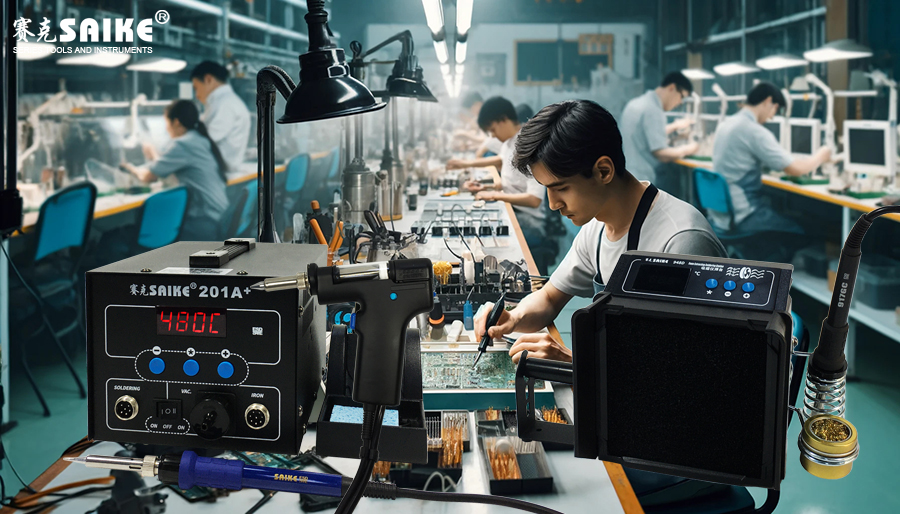
SK-YJ000HT-KP 100003
Soldering stations are essential tools in electronic manufacturing and repair, with diverse designs and functions adapted to various soldering needs and environments. Different types of soldering stations are equipped with their unique features and advantages, suitable for different operational requirements and technical levels. This article will introduce several common types of soldering stations and their characteristics in detail.
I. Basic Soldering Station
Characteristics:
– Simple Operation: Basic soldering stations usually have the most fundamental functions, suitable for beginners and basic electronic soldering work.
– Fixed Temperature: Most basic soldering stations do not have temperature adjustment functions or provide limited temperature settings.
– Cost-effective: These soldering stations are usually inexpensive due to their simple structure and low manufacturing costs.
Applications:
Suitable for home DIY projects, simple electronic repair work, and educational purposes, especially when the budget is limited and temperature control requirements are not high.
II. Variable Temperature Soldering Station
Characteristics:
– Temperature Control: Provides adjustable temperature control, allowing users to set appropriate temperatures for different soldering needs.
– Fast Heating: Adopts efficient heating technology to enable the soldering iron to quickly reach the set temperature.
– Temperature Stability: Advanced temperature control system ensures temperature stability during soldering, improving soldering quality.
Applications:
Suitable for professional electronic manufacturing, repair work, and precision engineering, especially for applications that require high temperature accuracy and stability.
III. Hot Air Soldering Station
Characteristics:
– Multi-function: In addition to conventional soldering functions, it also includes a hot air gun for various soldering and desoldering tasks.
– Temperature and Air Speed Adjustment: The temperature and air speed of the hot air gun can be adjusted for different SMD components and tasks.
– Surface Mount Device (SMD) Soldering: Particularly suitable for SMD soldering and repair, allowing precise heat control to avoid thermal damage to circuit boards and tiny components.
Applications:
Widely used in complex electronic manufacturing and repair work, especially in situations where hot air is required for surface mount technology (SMT) operations.
IV. Lead-free Soldering Station
Characteristics:
– Environmental Protection: Designed specifically for lead-free solder, complying with environmental regulations.
– High-temperature Operation: Lead-free solder usually requires a higher melting point, and these soldering stations support higher temperature settings.
– Health and Safety: Reduces the risk of lead poisoning and provides a safer work environment.
Applications:
Suitable for manufacturing environments that comply with RoHS directives and businesses that want to reduce the use of harmful substances in the workplace.
V. Repair Station Soldering Station
Characteristics:
– Integrated Design: Typically integrates various tools such as soldering irons, hot air guns, and solder suckers, providing a one-stop solution for various soldering and desoldering needs.
– Precise Control: Equipped with an advanced temperature control system and digital display for precise temperature and air speed control.
– Multi-purpose: Capable of handling various soldering tasks, including soldering and removing SMD and PTH (pin-through-hole) components.
Applications:
Particularly suitable for electronic repair service providers and multi-function workstations that require frequent repairs and maintenance of various electronic devices.
VI. Conclusion
Different types of soldering stations have unique functions and application areas. Choosing the appropriate type of soldering station can significantly improve work efficiency, soldering quality, and operational comfort. Understanding the characteristics and suitable environments of various soldering stations can help users make the best choice based on specific needs, whether it’s for simple DIY projects or complex industrial production. Correct selection and use of soldering stations directly affect product quality and production efficiency, which is the key to successful electronic manufacturing and repair work.


